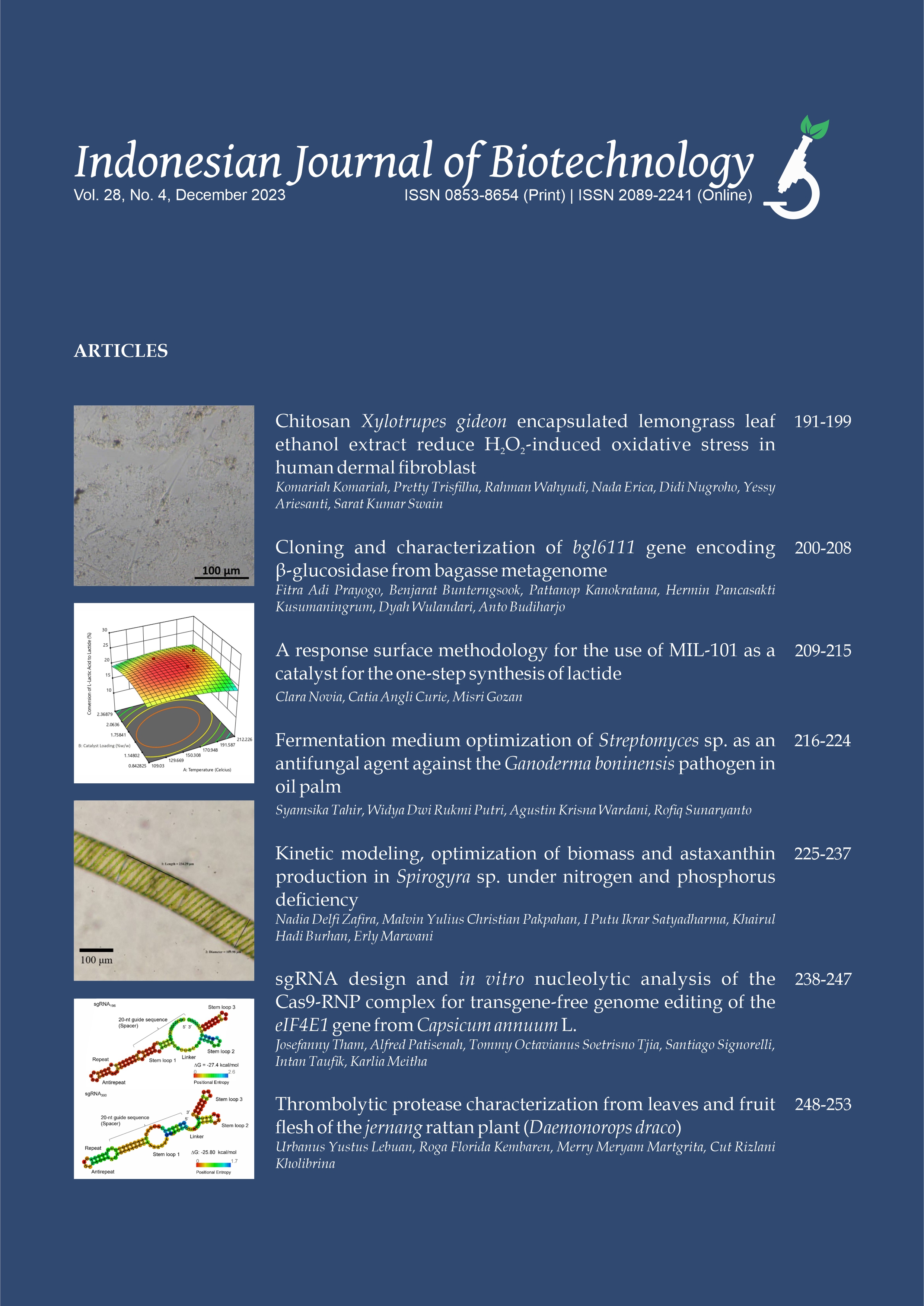Tetra‐primer amplification refractory mutation system (ARMS) PCR used to detect 3’UTR rs1948 mutation in CHRNB4
Anggi Laksmita Dewi(1), Dewi Kartikawati Paramita(2), Jajah Fachiroh(3*)
(1) Postgraduate student of Master of Biomedical Sciences, Faculty of Medicine, Public Health and Nursing, Universitas Gadjah Mada, Jl. Farmako Sekip, Yogyakarta 55281, Indonesia
(2) Department of Histology and Cell Biology, Faculty of Medicine, Public Health and Nursing, Universitas Gadjah Mada, Jl. Farmako Sekip, Yogyakarta 55281, Indonesia
(3) Department of Histology and Cell Biology, Faculty of Medicine, Public Health and Nursing, Universitas Gadjah Mada, Jl. Farmako Sekip, Yogyakarta 55281, Indonesia
(*) Corresponding Author
Abstract
Rs1948 A>G is a single nucleotide variation (SNV) in the 3’‐UTR of CHRNB4. Genotyping the synonymous CHRNB4 rs1948 may be useful in identifying a lung cancer susceptibility gene. The study aimed to develop a simple and easy tetra‐primer amplification refractory mutation system (ARMS PCR) for CHRNB4 rs1948. The following steps were taken to optimize tetra‐primer ARMS PCR: 1) determining the gene sequence and position of a single mutation; 2) developing outer and inner primers; 3) amplification of target gene fragments via PCR using an outer primer; 4) genotyping PCR product using Sanger sequencing; 5) determining the optimal annealing temperature and PCR cycle; 6) determining optimal outer and inner primer ratio; and 7) testing the reproducibility of the PCR program and final validation with Sanger sequencing. Genotype (PCR result) was visualized with 3% agarose gel electrophoresis. Optimum condition was determined as annealing temperature of 64.8 ºC and 35 cycles, outer and inner primer ratio of 1:6, and DNA volume of 3 µL. Sanger sequencing confirmed the results of the tetra‐primer ARMS PCR and it was shown that ARMS PCR was able to identify three different variants of CHRNB4 rs1948.
Keywords
Full Text:
PDFReferences
Berrettini WH, Doyle GA. 2012. The CHRNA5-A3-B4 gene cluster in nicotine addiction. Mol Psychiatry. 17(9):856–866. doi:10.1038/mp.2011.122.
Broms U, Wedenoja J, Largeau MR, Korhonen T, Pitkäniemi J, Keskitalo-Vuokko K, Häppölä A, Heikkilä KH, Heikkilä K, Ripatti S, et al. 2012. Analysis of detailed phenotype profiles reveals CHRNA5-CHRNA3-CHRNB4 gene cluster association with several nicotine dependence traits. Nicotine Tob Res. 14(6):720–733. doi:10.1093/ntr/ntr283.
Collins A, Ke X. 2012. Primer1 : Primer Design Web Service for Tetra-Primer ARMS-PCR. Open Bioinformatic J. 6:55–58. doi:10.2174/1875036201206010055.
Gallego X, Cox RJ, Laughlin JR, Stitzel JA, Ehringer MA. 2013. Alternative CHRNB4 3′-UTRs Mediate the Allelic Effects of SNP rs1948 on Gene Expression. PLoS One. 8(5):e63699. doi:10.1371/journal.pone.0063699.
Honardoost MA, Tabatabaeian H, Akbari M, Salehi M. 2014. Investigation of sensitivity , specificity and accuracy of Tetra primer ARMS PCR method in comparison with conventional ARMS PCR , based on sequencing technique outcomes in IVS-II-I genotyping of beta thalassemia patients. Gene. 549(1):1–6. doi:10.1016/j.gene.2014.05.071.
Jensen KP, Devito EE, Herman AI, Valentine GW, Gelernter J, Sofuoglu M. 2015. A CHRNA5 smoking risk variant decreases the aversive effects of nicotine in humans. Neuropsychopharmacology. 40(12):2813–2821. doi:10.1038/npp.2015.131.
Kapoor M, Wang JC, Bertelsen S, Bucholz K, Budde JP, Hinrichs A, Agrawal A, Brooks A, Chorlian D, Dick D, et al. 2012. Variants located upstream of CHRNB4 on chromosome 15q25.1 are associated with age at onset of daily smoking and habitual smoking. PLoS One. 7(3):e33513. doi:10.1371/journal.pone.0033513.
Lee SH, Ahn WY, Seweryn M, Sadee W. 2018. Combined genetic influence of the nicotinic receptor gene cluster CHRNA5/A3/B4 on nicotine dependence. BMC Genomics. 19(1):826. doi:10.1186/s12864-018-5219-3.
Medrano RFV, De Oliveira CA. 2014. Guidelines for the tetra-primer ARMS-PCR technique development. Mol Biotechnol. 56:599–608. doi:10.1007/s12033-014-9734-4.
Schaal C, Chellappan S. 2016. Nicotine-mediated regulation of nicotinic acetylcholine receptors in non-small cell lung adenocarcinoma by E2F1 and STAT1 transcription factors. PLoS One. 11(5):e0156451. doi:10.1371/journal.pone.0156451.
Scherf DB, Sarkisyan N, Jacobsson H, Claus R, Bermejo JL, Peil B, Gu L, Muley T, Meister M, Dienemann H, et al. 2013. Epigenetic screen identifies genotype- specific promoter DNA methylation and oncogenic potential of CHRNB4. Oncogene. 32(28):3329–3338. doi:10.1038/onc.2012.344.
Suhda S, Paramita DK, Fachiroh J. 2016. Tetra primer ARMS PCR optimization to detect single nucleotide polymorphisms of the CYP2E1 gene. Asian Pacific J Cancer Prev. 17(7):3065–3069. doi:10.4236/oalib.1104145.
Sun Y, Li J, Zheng C, Zhou B. 2018. Study on polymorphisms in CHRNA5/CHRNA3/CHRNB4 gene cluster and the associated with the risk of non-small cell lung cancer. Oncotarget. 9(2):2435–2444. doi:10.18632/oncotarget.23459.
Ye S, Dhillon S, Ke X, Collins AR, Day INM. 2001. An efficient procedure for genotyping single nucleotide polymorphisms. Nucleic Acids Res. 29(17):e88. doi:10.1093/nar/29.17.e88.
Zabala AS, Gomez MEV, Álvarez MF, Siewert S. 2017. Tetra Primer ARMS PCR Optimization to Detect Single Nucleotide Polymorphism of the KLF14 Gene. Open Access Libr J. 4:e4145. doi:10.4236/oalib.1104145.
Article Metrics
Refbacks
- There are currently no refbacks.
Copyright (c) 2022 The Author(s)

This work is licensed under a Creative Commons Attribution-ShareAlike 4.0 International License.









